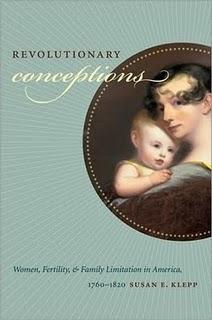Revolutionary Conceptions: Women, Fertility, and Family Limitation in America, 1760-1820

Susan E. Klepp’s Revolutionary Conceptions tracks the changes in family size ideals and the associated changes in family planning and women’s roles in early America. It is unsurprising that Klepp’s work highlights the limitations to women’s agency in family planning. Revolutionary Conceptions makes clear that women played an increasing role in determining the number of children they would have, and how this was tied to a greater presence of women outside of the domestic sphere.
Klepp reproduces letters from women who talk about their desire to have fewer children, which are usually followed by a revelation that woman, ultimately, gave birth to (by modern, typical North American views, anyway) a large number of children. Female slaves, were, alternately, wanted for their reproductive capacity and then sold for having had “too many” children when large families were no longer en vogue. Klepp also highlights some areas in which women had (limited) control. Women were brought to court to testify as experts in cases such as rape and infanticide; however, it was men who made the ultimate decisions in these cases. Klepp notes, “[I]n the colonies, month-to-month fertility decisions were left to women.”
Throughout the text, the author notes the difficulties in acquiring information about her topic. Early censuses, for example, routinely under-counted infants, particularly girls, which makes Klepp’s task of tracking changes in birth rates difficult. Klepp’s task is even more challenging due to the paucity of birth records for slaves. Further, when Klepp examines family planning, she quotes from letters and other texts in which women talk about limiting the number of children they would have, but the methods these women used were not shared.
In one interesting section, Klepp discusses herbs and concoctions used as emmenagogues (used to induce menstruation), abortifacients, and contraceptives, but notes, “Women usually made only oblique references to their use of these medicines and practices.” Despite this, Klepp is able to produce a highly detailed study of the issue.
I appreciate the comprehensiveness of Klepp’s approach. Not only does she support her study with statistics (represented in text as well as several graphs and tables), but she also includes artwork. Her chapter examining images of women describes and provides examples of portraits of women and their children, as well as husbands, from 1682 to approximately 1830. Klepp traces changes in women’s poses and the symbolism of the accessories that accompany them.
The main flaw I found in this chapter was in the accompanying examples. It is a shame that not all images that Klepp discusses are included in the book, and the black and white reproduction of the images that do appear has obscured many of the significant details Klepp describes; however, these issues do not detract from Klepp’s analysis.
Despite the vagaries, lost information, and reticence to have recorded information in the first place, Klepp has produced a highly detailed, fact-based, and—perhaps most importantly—interesting study of the declining number of children that early colonial American women bore, and what this meant for their agency both within and outside of the household.
It's not often that you see emmenagogues and abortifacients in the same sentence! What a fine review, Erin, of a book I need to get. Cheers. Lawrence